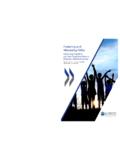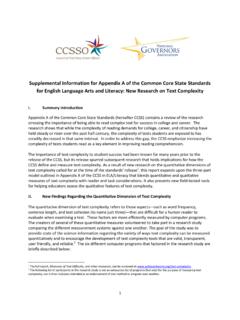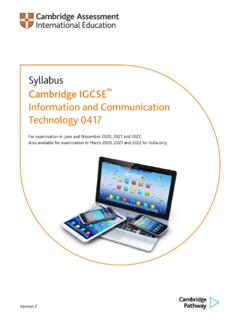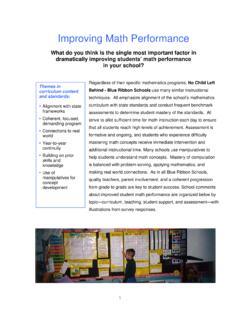Transcription of Designing Education Projects - ERIC
1 Designing Education Projectsa Comprehensive approaCh toneeds assessment, project planning and implementation, and evaluationabcSECOND EDITIOND esigning Education ProjectsDesigning Education Projectsa Comprehensive approaCh toneeds assessment, project planning and implementation, and evaluationsecond editionnational oceanic and atmospheric Department of CommerceapriL 2009 AcknowledgmentsThis manual is intended to assist NOAA professionals as they design and implement Education of Part II: Project Planning and Implementation is based on the Project Design and Evaluation course offered by the NOAA Coastal Services and case studies integral to this manual were developed with the help of Education and outreach staff in the following NOAA line offices.
2 National Weather Service (NWS), National Marine Fisheries Service (NMFS), National Ocean Service (NOS) and Oceanic and Atmospheric Research (OAR) as well as field staff from the National Sea Grant College Program (NSGCP), the National Estuarine Research Reserve System (NERRS), and the Office of National Marine on the Targeting Outcomes of programs (TOP) model was based on the work of Bennett and Rockwell (1995, 2004). Feedback on logic model terminology was provided by NOAA Program Planning and Integration staff members Susan Kennedy, Robert Fulton, and Tom , the following individuals reviewed the second edition of this manual:Molly Harrison, NOAA, National Marine Fisheries ServiceAtziri Iba ez, NOAA, National Estuarine Research Reserve SystemChris Maier, NOAA, National Weather ServiceJohn McLaughlin, NOAA Office of EducationDiana Payne, Connecticut Sea Grant College ProgramSarah Schoedinger, NOAA, Office of EducationSteve Storck, NOAA, Office of EducationTheir assistance is truly appreciated.
3 First edition, June 2005:Bora SimmonsEnvironmental EducationDepartment of Teaching and LearningNorthern Illinois UniversityDeKalb, IL 60115 Second edition, April 2009:Elizabeth A. Day-Miller and Janice O. EastonBridgeWater Education Consulting, LLCB ridgewater, VA of ContentsIntroduction .. 1 Who Should Use This Manual? .. 1A Word about programs and Projects .. 2 Project Development as a Cycle .. 3 How is this Manual Organized? .. 3 Part I. Needs Assessment .. 7 Introduction .. 7 What is a Needs Assessment? .. 7 Why is Needs Assessment Important to Project Design and Implementation? .. 8 Planning a Needs Assessment .. 10 Should a Consultant be Hired? .. 23 Part I Wrap Up.
4 23 Part II. Project Planning and Implementation .. 25 Introduction .. 25 Planning and Implementing an Education Project .. 25 Part II Wrap Up .. 42 Part III. Project Evaluation .. 43 Introduction .. 43 What is Project Evaluation? .. 43 Why is Evaluation Important to Project Design and Implementation? .. 45 Planning an Evaluation .. 47 Who Should Conduct the Evaluation? .. 54 Evaluation Costs .. 55 Ethics .. 56 Part III Wrap Up .. 56 Part IV. Data Collection Instruments .. 57 Introduction .. 57 Matching Data Collection Instruments to What is Being Assessed .. 57 Validity and Reliability of Evaluation Instruments .. 58 Mixed Methods.
5 58 Types of Data Collection Instruments .. 59 Selecting the Right Data Collection Instrument .. 62 Appendix A. Fact Sheets on Data Collection Instruments .. 67 Appendix B. Determining Sample Size .. 81 Appendix C. Logic Model and Performance Measures .. 83 Appendix D. Levels of Evaluation .. 85 Glossary .. 90 Selected References .. 911 IntroductionIntroductionAconsiderable amount of time, effort, and other resources go into the development and implementation of Education Projects . Quite obviously, the goal is to create effective Projects that can serve as models of excellence. Whether the project is an hour-long endangered species talk, a family festival, a severe weather awareness workshop, marine resources monitoring, or a community forum, the aim of providing quality educational experiences remains the Should Use This Manual?
6 This manual has been developed to help project managers and Education coordinators who design Education Projects take the development process to a new level of excellence. The manual walks through the basics of needs assessment, project planning and implementation, and evaluation. This information is intended to answer questions about the project development process and to be used as an overall project improvement tool. A systematic approach to the overall project planning and implementation process is outlined. Education coordinators are encouraged to take a step back and make considered decisions that will result in increased effectiveness. Specifically, using the process described in this manual will help you:O Match agency s needs and capability: Throughout the process, you will be asked to consider how the project addresses the agency s mission.
7 Knowing how the project fits within the agency s priorities will ensure strategic use of resources and help you build internal support for the project. You will be able to articulate why this project is important and why NOAA should support Set realistic and meaningful goals, objectives, and outcomes: From the development of the needs assessment to Designing the final evaluation and everything in between, you will know what you want to accomplish and if you actually accomplished it. You will set objectives that are measurable and worth measuring. You will focus your project on outcomes that make a difference and ensure that a direct relationship exists between outcomes and project components.
8 In a time of increasing attention to accountability, you will be able to document educational Use limited resources wisely: By identifying measurable objectives based on well-thought-out and researched priorities, Projects will be focused and resources will be used efficiently. At various points in the project design process, you will be asked to inventory existing materials and programs . By taking stock, you will avoid re-inventing the wheel. Judiciously adapting or adopting materials saves both time and Design effective and sustainable Projects : Projects that are designed with best practices in mind are more effective: continuous project improvement becomes integral to the process, evaluation is not left to the end, stakeholders needs are consciously 2 Designing Education Projectsaddressed throughout, and credibility is built.
9 When decision-makers and others see results and meaningful partnerships established, Projects are truly sustainable. O Enhance the learning process: In the end, Education Projects are developed because of the learner. Projects are developed because we want participants to gain specific knowledge and skills. Education Projects are developed to promote public safety and the development of environmental and scientific literacy. Careful attention to the design and implementation of an Education project will be reflected in learner outcomes. It should be noted at the outset that this manual outlines an ideal process for the design of high quality Education Projects . Developing appropriate budgets and schedules are, obviously, key to the ultimate success of the Education project.
10 Without proper attention to budget details, a project may never make it beyond the early stages of planning. Similarly, poor scheduling may mean that materials are not ready when needed or evaluation opportunities are missed. Although both budgeting and scheduling will impact the quality of the project, the focus of this manual is on the design of the Education intervention and its project is different, however, varying in scope and duration. Materials developed for a one-shot event at an elementary school will be very different from those developed for a community group that meets on a regular basis. Projects vary in the amount of resources (human as well as monetary) available.














